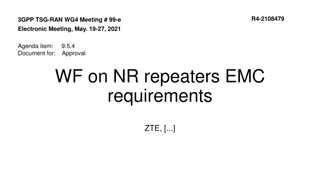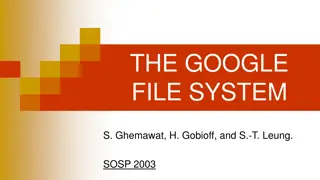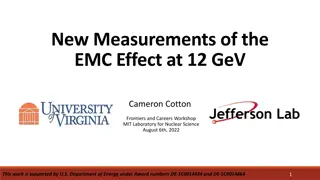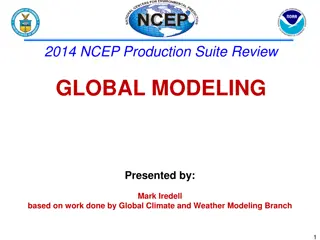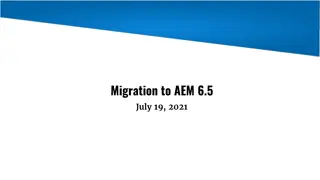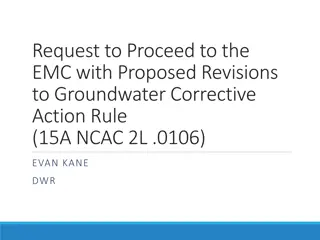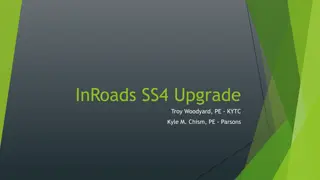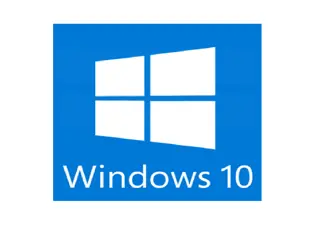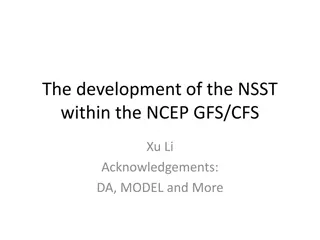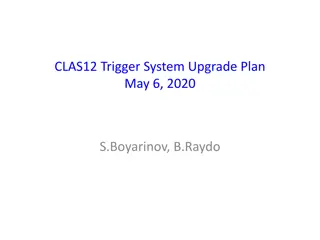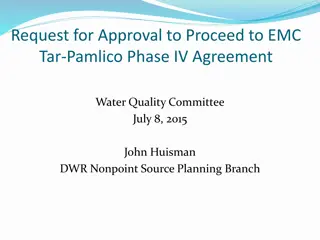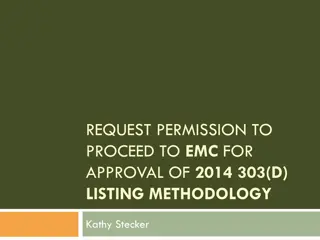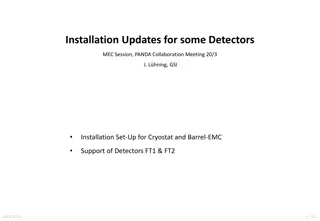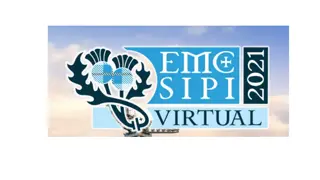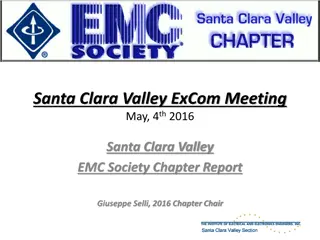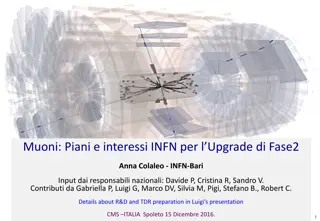EMC FY15Q1 Upgrade Review for GFS System
Upgrade review presented by Mark Iredell on the planned system changes and expected benefits for the Global Forecast System (GFS) in December 2014. Highlights include enhancements to modeling capabilities, forecast accuracy, and system optimizations across various components like analysis, model dynamics, physics upgrades, and boundary condition inputs.
Download Presentation

Please find below an Image/Link to download the presentation.
The content on the website is provided AS IS for your information and personal use only. It may not be sold, licensed, or shared on other websites without obtaining consent from the author. Download presentation by click this link. If you encounter any issues during the download, it is possible that the publisher has removed the file from their server.
E N D
Presentation Transcript
EMC FY15Q1 Upgrade Review N C E P GFS upgrade Presented by: Mark Iredell based on work done by Global Climate and Weather Modeling Branch 1
Implementation Overview This upgrade is planned for December 9, 2014 System description This is a change to the GDAS and GFS. What s being changed in the system Analysis Model T1534 (to 10 days) Semi-Lagrangian Use of high resolution daily SST and sea ice analysis Physics Land Surface Post Processor Expected benefits to end users associated with upgrade Upgrade in global modeling capability. Improvement in forecast skill This implementation will put GFS/GDAS into EE process. 2
Analysis Highlights Structure T574 (35 km) analysis for T1534 (13 km) deterministic Code optimization Observations GPSRO enhancements improve quality control Updates to radiance assimilation Assimilate SSM/IS UPP LAS and MetOp-B IASI radiances CRTM v2.1.3 New enhanced radiance bias correction scheme Additional satellite wind data hourly GOES, EUMETSAT EnKF modifications Stochastic physics in ensemble forecast T574L64 EnKF ensembles 3
Model Highlights (1) T1534 Semi-Lagrangian (~13 km) Use of high resolution daily SST and sea ice analysis High resolution until 10 days Dynamics and structure upgrades Hermite interpolation in the vertical to reduce stratospheric temperature cold bias. Restructured physics and dynamics restart fields and updated sigio library Divergence damping in the stratosphere to reduce noise Added a tracer fixer for maintaining global column ozone mass Major effort to make code reproducible 4
Model Highlights (2) Physics upgrades Radiation modifications -- McICA Reduced drag coefficient at high wind speeds Hybrid EDMF PBL scheme and TKE dissipative heating Retuned ice and water cloud conversion rates, background diffusion of momentum and heat, orographic gravity-wave forcing and mountain block etc Stationary convective gravity wave drag Modified initialization to reduce a sharp decrease in cloud water in the first model time step Correct a bug in the condensation calculation after the digital filter is applied 5
Model Highlights (3) Boundary condition input and output upgrades Consistent diagnosis of snow accumulation in post and model Compute and output frozen precipitation fraction New blended snow analysis to reduce reliance on AFWA snow Changes to treatment of lake ice to remove unfrozen lake in winter Land Surface Replace Bucket soil moisture climatology by CFS/GLDAS Add the vegetation dependence to the ratio of the thermal and momentum roughness, Fixed a momentum roughness issue 6
Post - Processer Highlights Faster/less memory version GRIB2 with parallel output Master post file is 0.25 degree, not model Gaussian grid Accumulation bucket changed from 12 hour to 6 hour between day 8 and day 10 Add user requested fields frozen precipitation fraction ozone at 150, 200, 250, 300, 350, and 400 mb, 2m dew point, wind chill and heat index, instantaneous precipitation type membrane SLP in GDAS pgb files Improved icing algorithm in post Higher precision RH GDAS output symmetric with GFS BUFR station list to newer NAM/GFS list 7
Parallel Status All components of the system , including Storm-Relocation, OBSPROC, EMC- Surface, GSI, ENKF, GSM, Post-processing, were built in the EE structure, are frozen, and have been handed off to NCO for implementation. NCO is working on setting up a 30-day pre-implementation parallel, which will be run on the development machine. Parallels and verification pages Prhs14: 01/01/2014 ~ present http://www.emc.ncep.noaa.gov/gmb/wd20rt/vsdb/prhw14 Prhs13: 05/16/2013 ~ 12/31/2013 http://www.emc.ncep.noaa.gov/gmb/wd20rt/vsdb/prhs13 Prhs12: 05/01/2012 ~ 11/06/2012 http://www.emc.ncep.noaa.gov/gmb/wd20rt/vsdb/prhs12 Prhs11: 05/20/2011 ~ 12/31/2011 http://www.emc.ncep.noaa.gov/gmb/wx24fy/vsdb/prhs11 http://www.emc.ncep.noaa.gov/gmb/wx24fy/vsdb/prhs11b/ merged 2012/2013/2014 http://www.emc.ncep.noaa.gov/gmb/wx24fy/vsdb/gfs2015/ running completed completed completed (on Zeus) 8
Results Merged 2012/2013/2014 see http://www.emc.ncep.noaa.gov/gmb/wx24fy/vsdb/gfs2015/ for more detail. Note that Hybrid ENKF 3D-VAR GSI was implemented into operation after May 22, 2012 NH 500-hPa HGT AC SH 500-hPa HGT AC Link to scorecard http://www.emc.ncep.noaa.gov/gmb/wx24fy/vsdb/gfs2015/www/s corecard/mainindex.html 9
Real-Time Parallel in the past 31 Days NH 500-hPa HGT AC Prhw14 is T1534 parallels SH 500-hPa HGT AC http://www.emc.ncep.noaa.gov/gmb/STATS_vsdb/ 10
Precipitation Skill Scores, 00Z Cycle Merged 2012/2013/2014 BIAS ETS Improved ETS score and reduced forecast BIAS for all intensity and forecast lead time. 11
Precipitation Skill Scores, 12Z cycle Merged 2012/2013/2014 Improved ETS score and slightly reduced forecast BIAS for all intensity and forecast lead time. 12
Fit to RAOBS, RMSE Merged 2012/2013/2014 Global Mean Wind RMSE Global Mean Temperature RMSE http://www.emc.ncep.noaa.gov/gmb/wx24fy/vsdb/gfs2015/g2o/index.html 13
Fit to RAOBS, Bias Merged 2012/2013/2014 Global Mean Wind Bias Global Mean Temperature Bias Reduced tropospheric warm bias, increased near surface warm bias Strengthened tropospheric wind, slightly weakened stratospheric wind 14
CONUS T2m, Fit to Sfc Obs Merged 2013/2014 Northwest Northern Plains Reduced nighttime cold bias Southwest Northeast Southern Plains Southeast 15
10-m Wind and 2m RH, Fit to Sfc Obs Merged 2013/2014 10m Wind CONUS West CONUS East CONUS West 2m RH CONUS West CONUS East 16
Hurricane Verification 2012/2013/2014 Atlantic Track Atlantic Intensity Eastern Pacific Track Eastern Pacific Intensity 17
Hurricane Verification 2012/2013/2014 Western Pacific Track Western Pacific Intensity 18
Hurricane Track Verification, 2011 HS11: T1534 parallel ENKF: T574 ENKF-3DVAR parallel Atlantic ENKF was run only for part of the 2011 hurricane season (08/20/2011 10/16/2011) Eastern Pacific Western Pacific 19
2012 Hurricane Sandy Summary: At day 7, HS12 is significantly better than AVNO. HS12 showed the tendency to move Sandy northwestward. At day 6, HS12 is slightly better than AVNO, but the difference is small. At day-5 and day-4, the results are mixed. HS12 is better than AVNO for certain cycles but worse for other cycles. At day 3 and less, HS12 is much better than AVNO. HS12 forecast is as good as or slightly better than ECMWF forecast. Overall, the forecast of hurricane Sandy s track is improved in the experimental T1534 semi-lag GFS in comparison with the operational T574 Eulerian GFS. The improvement is most significant for short-lead forecast within 72 hours. Long-lead 6 to 7-day forecasts showed improvement for certain cycles. 20
Mean Track and Intensity Errors 22 - 30 October 2012, 4 cycles/day 21
Tracks from Forecast Cycles 20121022: 12Z and 18Z 7 days before landfall 12Z 18Z 22
Tracks from 20121023: 00Z, 06Z, 12Z and 18Z Cycles 6 days before landfall 06Z 00Z 18Z 12Z 23
Tracks from 20121024: 00Z, 06Z, 12Z and 18Z Cycles 5 days before landfall 06Z 00Z 18Z 12Z 24
Tracks from 20121025: 00Z, 06Z, 12Z and 18Z Cycles 4 days before landfall 06Z 06Z 00Z 18Z 12Z 25
Tracks from 20121026: 00Z, 06Z, 12Z and 18Z Cycles 3 days before landfall 00Z 06Z 12Z 18Z 26
Extratropical Cyclone Track Errors (fcst cs analy) June-Aug 2014 (Lat > 20N/S) Courtesy of Guang Ping Luo 250 GFSPn GFSOn GFSPs GFSOs 200 track errors (NM) 150 100 50 0 0 12 24 36 48 60 72 84 96 108 120 fcst hr NH cases SH cases 0 12 24 36 48 793 564 60 513 309 72 331 157 84 96 135 43 108 97 19 120 71 2145 1880 1995 1742 1752 1545 1248 1014 217 79 8
Summary All codes are now frozen, built in EE structure, and handed off to NCO for implementation. Results are reasonable Improved precipitation skill scores Improved hurricane track in Atlantic and Western Pacific, but worsened in Eastern Pacific; Reduced intensity errors in all basins. Reduced mid-latitude storm track errors. Reduced global mean temperature bias in the upper troposphere; strengthened (improved) tropospheric winds but slightly weakened stratospheric winds. Reduced nighttime 2m temperature cold bias over the Northern Great Plains. Large biases still exist in Northeast and Southwest. improved 500-hPa HGT AC in both the Northern and Southern Hemispheres. 28


